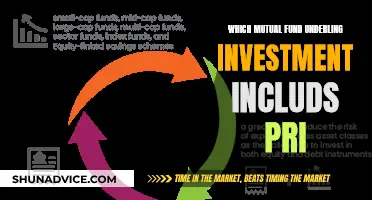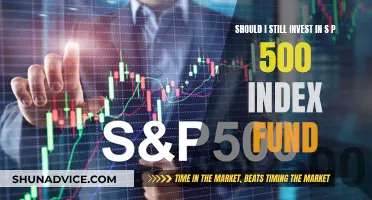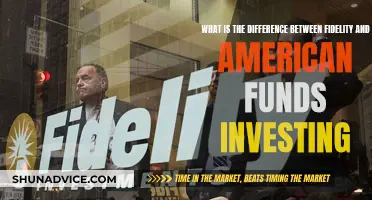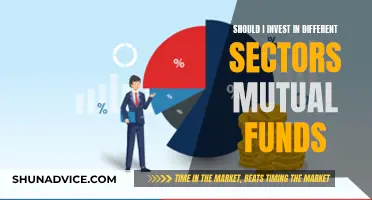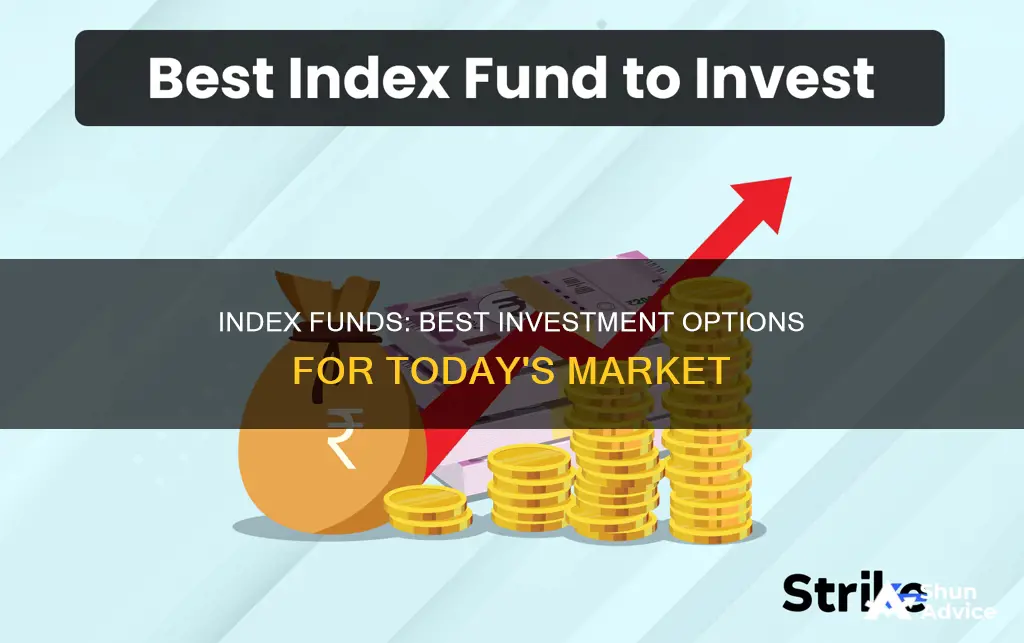
Index funds are a type of mutual fund or exchange-traded fund (ETF) that tracks the performance of a market index, such as the S&P 500, by holding the same stocks or bonds or a representative sample of them. They are passively managed and have lower fees than actively managed funds. Index funds are a good option for beginners as they are a simple, cost-effective way to hold a broad range of stocks or bonds. When choosing an index fund to invest in, it is important to consider the fund's performance history, management fees, and the indexes they track.
| Characteristics | Values |
|---|---|
| Name of Index Fund | Vanguard S&P 500 ETF |
| Overview | The Vanguard S&P 500 ETF tracks the S&P 500 index and is one of the largest funds on the market with hundreds of billions in the fund. |
| Expense Ratio | 0.03% |
| 5-year Annualized Return | 15.6% |
| Who is it Good For? | Investors looking for a broadly diversified index fund at a low cost to serve as a core holding in their portfolio |
| How to Buy | The fund can be purchased directly from the fund company or through most online brokers |
What You'll Learn

Broad market index funds
Fidelity ZERO Large Cap Index (FNILX)
This fund is a mutual fund offered by Fidelity that tracks the Fidelity U.S. Large Cap Index, which is similar to the S&P 500. It has no expense ratio, meaning there are no fees associated with investing in this fund. The fund has a strong 5-year annualized return of 15.7%. It is a good option for investors looking for a broadly diversified index fund at a low cost.
Vanguard S&P 500 ETF (VOO)
The Vanguard S&P 500 ETF is a large fund that tracks the S&P 500 index. It is backed by Vanguard, a well-known name in the industry. The fund has an expense ratio of 0.03%, which means that for every $10,000 invested, you would pay $3 annually. It has a 5-year annualized return of 15.6%. This fund is suitable for investors seeking broad diversification at a low cost.
SPDR S&P 500 ETF Trust (SPY)
The SPDR S&P 500 ETF is one of the oldest ETFs, having been founded in 1993. It tracks the S&P 500 and is sponsored by State Street Global Advisors. The fund has an expense ratio of 0.095%, which equates to $9.50 for every $10,000 invested. Its 5-year annualized return is 15.6%. This fund is a good choice for investors seeking broad market exposure at a reasonable cost.
IShares Core S&P 500 ETF (IVV)
The iShares Core S&P 500 ETF is sponsored by BlackRock, one of the largest fund companies. This ETF tracks the S&P 500 and has been in existence since 2000. It has a low expense ratio of 0.03%, or $3 for every $10,000 invested. The fund has a 5-year annualized return of 15.6%. It is a good option for investors seeking broad diversification and low costs.
Schwab S&P 500 Index Fund (SWPPX)
The Schwab S&P 500 Index Fund is sponsored by Charles Schwab and has a strong track record dating back to 1997. It is a mutual fund with a very low expense ratio of 0.02%, or $2 for every $10,000 invested. The fund has a 5-year annualized return of 15.6%. This fund is a good choice for investors seeking a well-established, low-cost option for broad market exposure.
These broad market index funds offer investors a way to gain diversified exposure to the stock market as a whole. When considering which fund to invest in, it is important to evaluate factors such as the fund's performance, expense ratio, and your own investment goals and risk tolerance.
Best Platforms for Direct Mutual Fund Investments
You may want to see also

International index funds
Vanguard Total International Stock Index Fund Admiral Shares (VTIAX)
This fund seeks to track the FTSE Global All Cap ex US Index, which measures the performance of stocks from companies outside the United States. It has a minimum investment requirement of $3,000 and a net expense ratio of 0.12%. The fund's top market allocations include Japan, the United Kingdom, Canada, France, and China. Over the past 10 years, it has returned 4.18%, slightly underperforming its benchmark, which returned 4.27% during the same period.
Vanguard Developed Markets Index Fund Admiral Shares (VTMGX)
The Vanguard Developed Markets Index Fund is another great option, tracking the performance of the Spliced Developed ex US Index. It has an exceptionally low turnover ratio of 2.7%, making it highly tax-efficient. The fund invests primarily in large- and mid-cap stocks of developed markets, with Japan, the United Kingdom, and Canada as its top allocations. There are no load fees, and it has returned 4.61% to investors over the last 10 years, slightly outperforming its benchmark.
Fidelity International Index Fund (FSPSX)
The Fidelity International Index Fund tracks the MSCI Europe, Australasia, Far East Index (EAFE), focusing on developed markets. It offers a diversified portfolio at a low cost, with a net expense ratio of 0.035%. European stocks have the largest allocation, followed by Japanese equities. The fund provides significant exposure to financial and industrial stocks. Over the past 10 years, it has returned 4.53%, slightly underperforming its benchmark.
Schwab International Index Fund (SWISX)
The Schwab International Index Fund seeks to track the MSCI EAFE Index, exposing investors to foreign currency fluctuations. European and Japanese companies make up a significant portion of its portfolio, with the financial, industrial, health care, and consumer discretionary sectors as its top allocations. The fund has a low net expense ratio of 0.06% and a decent turnover ratio of 13.43%, making it attractive for tax efficiency. Over the past 10 years, it has returned 4.43% to investors.
When considering these international index funds, it's important to evaluate your investment goals, strategies, and risk tolerance. Remember that international funds carry their own set of risks, and it's essential to do your due diligence before investing.
Invest in Socially Responsible Mutual Funds: Make Money, Change the World
You may want to see also

Bond index funds
Fidelity U.S. Bond Index Fund (FXNAX)
FXNAX is one of three Fidelity total bond market index funds on our list. It was launched in May 2011 and has an average annual turnover of 34%. The fund offers exposure to U.S. Treasurys, mortgage-backed securities, and corporate bonds, with an average effective duration of about six years. With minimal credit risk and a low expense ratio, FXNAX is a sound choice for investors seeking a well-diversified bond index mutual fund.
Vanguard Total Bond Market Index Fund Admiral Shares (VBTLX)
VBTLX is one of the oldest bond index funds, with its oldest share class dating back to 1986. The fund tracks the Bloomberg U.S. Aggregate Float Adjusted Index and requires a minimum initial investment of $3,000. VBTLX offers exposure to U.S. Treasurys, agency bonds, mortgage-backed securities, and industrial issuer debt. With a heavy weighting in high-quality, investment-grade assets, VBTLX can provide stability during volatile market conditions.
Schwab U.S. Aggregate Bond Index Fund (SWAGX)
SWAGX is a strong contender for the best total bond market index fund. Launched in February 2017, it has a 58% turnover ratio, indicating a willingness to replace lower-yielding bonds with higher-rate assets. The fund is heavily weighted towards U.S. government and agency bonds, mortgage-backed securities, and investment-grade corporate bonds. SWAGX is a suitable option for shareholders seeking a low-fee intermediate bond fund without a required minimum investment.
TIAA-CREF Bond Index Advisor (TBIAX)
TBIAX is a core U.S. bond index fund that tracks the Bloomberg Barclay's U.S. Aggregate Bond Index. It holds a diversified portfolio of over 8,500 bonds, including government securities, mortgage-backed securities, and investment-grade assets. The fund has an average effective duration of about six years, indicating a potential value decline of 6% for each 1% annual rise in interest rates. TBIAX is a well-diversified and stable option for investors.
Northern Bond Index (NOBOX)
NOBOX is one of the older bond index funds, founded in February 2007, with an ultra-low expense ratio. The fund requires a minimum initial investment of $2,500 and holds approximately 3,300 bonds. NOBOX has an average effective duration of roughly seven years and allocates about 40% to U.S. Treasurys, 25% to mortgage-backed securities, and the remainder primarily to investment-grade corporate bonds. Its higher turnover benefits shareholders by adding higher-yielding bonds as interest rates rise.
Mutual Fund SIPs: Where to Invest for Maximum Returns
You may want to see also

Growth index funds
IShares Core S&P US Growth ETF
This ETF offered by iShares, one of the largest fund companies, tracks the S&P 900 Growth Index, which is composed of large- and mid-capitalization U.S. equities that exhibit strong growth characteristics. With an inception date of 2000, this fund has a long-standing track record and has total assets worth $18.93 billion.
Vanguard Mega Cap Growth ETF
This ETF offered by Vanguard, a powerhouse in the fund industry, seeks to track the performance of the CRSP US Large Cap Growth Index. This index measures the investment return of large-capitalization growth stocks. With total assets of $19.57 billion, this fund provides investors with exposure to some of the largest companies in the U.S. that are expected to exhibit high growth rates.
Vanguard S&P 500 Growth ETF
This ETF, also offered by Vanguard, tracks the S&P 500® Growth Index, which focuses on large-capitalization growth stocks. With total assets of $10.82 billion, this fund provides investors with access to a broad range of large-cap companies that are expected to experience high growth.
Fidelity Momentum Factor ETF
This ETF, offered by Fidelity, seeks to provide investment returns that correspond to the performance of the Fidelity U.S. Momentum Factor Index. With total assets of $223.46 million, this fund offers investors a way to capitalize on companies exhibiting strong momentum and growth potential.
Invesco NASDAQ 100 ETF
With total assets of $28.86 billion, this ETF offered by Invesco tracks the performance of the NASDAQ-100 Index®, which is heavily weighted towards technology and growth-oriented companies. By investing in this fund, you will gain exposure to some of the largest and fastest-growing companies in the U.S.
When considering growth index funds, it is important to remember that they are generally riskier than more diversified funds. Conduct thorough research, assess your risk tolerance, and consult with a financial advisor before making any investment decisions.
Pension Fund Investment: Where to Invest for Maximum Returns
You may want to see also

Value index funds
When considering value index funds, it is important to understand the underlying strategy and approach taken by the fund manager. Some funds may utilise a deep-value approach, focusing primarily on fundamental valuation metrics such as price-to-earnings, price-to-book, or price-to-sales ratios. Other funds may blend these valuation metrics with a quality screen, aiming to invest in undervalued companies that also demonstrate strong profitability and financial health.
Additionally, value index funds can vary in terms of the size of companies they focus on. Some funds may invest in stocks of larger, more established companies, while others may target smaller companies with potential for future growth. It is also worth noting that some value funds place a greater emphasis on dividend-paying stocks, while others may prioritise capital appreciation over income generation.
When evaluating specific value index funds, here are some options to consider:
- Vanguard Value Index Fund (VIVAX): This fund focuses on large-cap value stocks and is offered by Vanguard, a well-known provider of low-cost index funds. It has a diversified portfolio and a low turnover of stocks. However, it is currently closed to new investors, but the Admiral shares version can be purchased for a minimum investment of $3,000.
- Vanguard S&P Mid-Cap 400 Value Index: This fund targets mid-cap value stocks and is part of Vanguard's family of low-cost index funds.
- Vanguard Small-Cap Value Index Admiral: For those interested in exposure to smaller companies, this fund invests in small-cap value stocks and is also offered by Vanguard.
- American Funds American Mutual (AMRMX): This fund is managed by American Funds and focuses on identifying undervalued stocks across different market capitalisations.
- Diamond Hill Large Cap (DHLYX): Managed by Diamond Hill, this fund targets large-cap value stocks and aims to invest in companies trading below their intrinsic value.
- Dodge & Cox Stock (DODGX): The Dodge & Cox Stock fund takes a long-term approach to investing in undervalued companies, focusing on both large and mid-cap stocks.
- Harbor Mid Cap Value (HAMVX): Offered by Harbor, this fund invests in mid-cap value stocks and aims to identify companies with strong fundamentals and attractive valuations.
It is important to note that value index funds, like any investment, carry a certain level of risk. Value stocks may underperform growth stocks during certain market conditions, and there is no guarantee that the targeted undervalued stocks will appreciate as expected. Therefore, it is essential to conduct thorough research and due diligence before investing in any value index fund.
Researching Investment Funds: A Guide to Getting Started
You may want to see also
Frequently asked questions
Index funds are a type of mutual or exchange-traded fund (ETF) that tracks the performance of a market index, such as the S&P 500, by holding the same stocks or bonds or a representative sample of them.
Index funds are very popular among investors because they offer a simple, no-fuss way to gain exposure to a broad, diversified portfolio at a low cost. They are passively managed and often have low expense ratios.
One drawback is the lack of downside protection; in prolonged downtrends, these funds can perform poorly in line with the broader market. They also lack flexibility as they are designed to mirror a specific market and can't pivot away when the market shifts.
First, choose an investment platform or online brokerage. Then, open and fund an account. Next, select an index fund by researching the fund's performance history, management fees, and the indexes they track. Finally, buy shares through the website or app.
This depends on your financial situation, goals, and risk tolerance. Generally, if you have a 6-month emergency fund, have maxed out your 401k and IRA, and have leftover cash, then you can consider investing. The proportion of your investment across different funds depends on your risk appetite.


